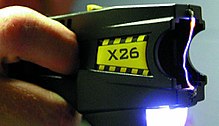
Back صعاقة Arabic Електрошоково оръжие Bulgarian Arma d'electroxoc Catalan Elektrický paralyzér Czech Elektrochokvåben Danish Elektroimpulswaffe German Elektroŝoka armilo Esperanto Arma de electrochoque Spanish Elektrišokirelv Estonian باتون برقی Persian

An electroshock weapon is an incapacitating weapon. It delivers an electric shock aimed at temporarily disrupting muscle functions and/or inflicting pain, usually without causing significant injury.
Many types of these devices exist. Stun guns, batons (or prods), cattle prods, shock collars, and belts administer an electric shock by direct contact, whereas Tasers fire projectiles that administer the shock through thin flexible wires. Long-range electroshock projectiles, which can be fired from ordinary shotguns and do not need the wires, have also been developed.
Though the two terms are often used interchangeably, stun guns are actually direct contact weapons that work mainly through pain compliance by affecting the sensory nervous system.[1] It can also cause some muscular disruption, but that generally requires 3–5 seconds of direct contact.[2] In comparison, a Taser is a long range weapon that fires barbed darts and incapacitates the target by disrupting voluntary muscular control through the motor nervous system.[2][3] However, some models of Taser blur this distinction as they are capable of delivering a "drive stun", a pain compliance technique involving placing the weapon in direct contact with the subject's body and discharging a shock without firing the probes. [4]
- ^ Faircloth, Ulrich. "Stun Gun Myths". www.srselfdefense.com. Stun & Run Self Defense. Archived from the original on 2019-03-29. Retrieved 2018-12-07.
- ^ a b Carson, Andrea. "What Is the Difference Between a Stun Gun & Taser?". sciencing.com. Sciencing. Archived from the original on 2018-12-09. Retrieved 2018-12-07.
- ^ "Taser vs Stun Gun". blog.taser.com. TASER Self-Defense. Archived from the original on 2019-04-06. Retrieved 2018-12-07.
- ^ Law Enforcement Advisory Committee (Summer 2005). "Less Lethal Weapons: Model Policy and Procedure for Public Safety Officers" (PDF). Michigan Municipal Risk Management Authority. Archived from the original (PDF) on August 20, 2008. Retrieved May 12, 2009.
{{cite journal}}: Cite journal requires|journal=(help)
© MMXXIII Rich X Search. We shall prevail. All rights reserved. Rich X Search